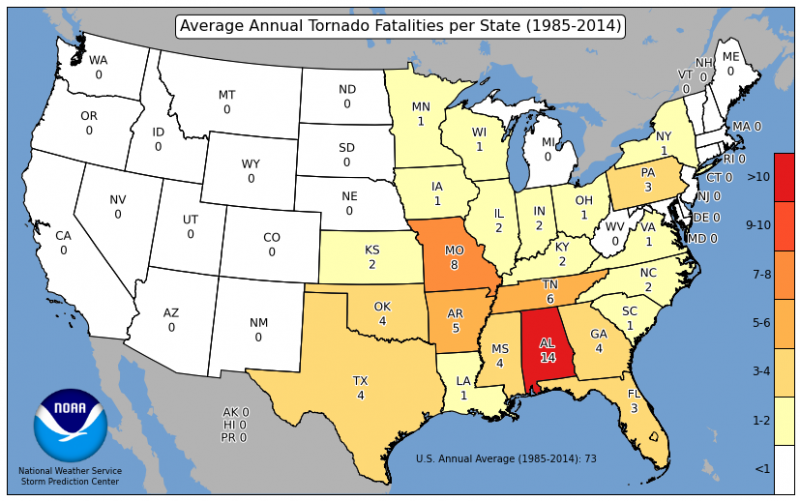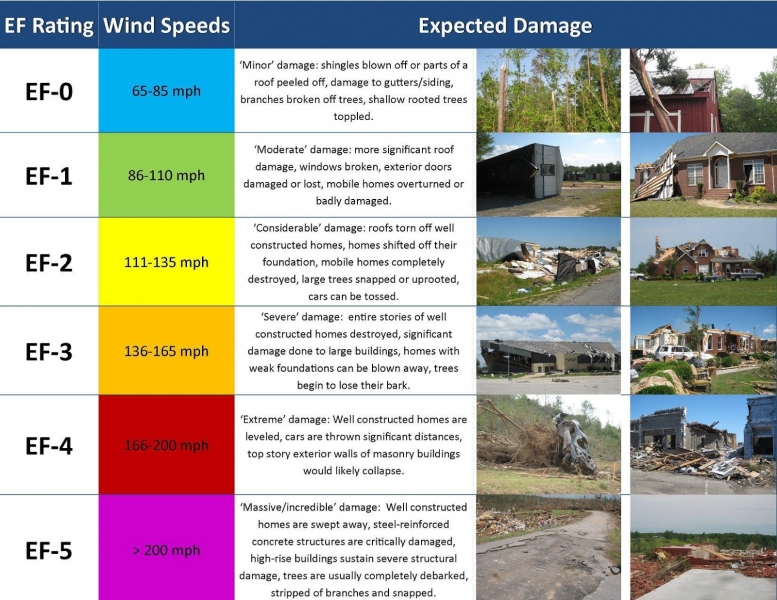During Severe Weather Preparedness Week we are reminded that weather-related disasters can occur in every area of the United States. Due to geographical features and other aspects, some regions are more prone to certain disasters than others. Recently, one of our southern most states, Texas, was hit with a widespread winter storm and record breaking arctic outbreak that knocked out power and water—making it difficult for people to stay safe. But as we’ve seen, winter weather can impact any portion of our country.
The NOAA Office of Response and Restoration Disaster Preparedness Program (DPP) and the NOAA National Weather Service (NWS) remind us that tornadoes are another weather-related disaster that can actually occur in many areas. While people commonly think of “Tornado Alley” in the area that sees the most tornadoes each year, the truth is that tornadoes are prevalent over a large portion of the eastern United States from the Great Plains east into the Midwest, Lower Mississippi River Valley, and even the southeastern United States. In fact, over half of the deadliest tornadoes on record have occurred outside of the traditional “Tornado Alley."

Tornadoes Can Happen Anywhere
By definition, a tornado is part of a severe convective storm, and these storms occur all over the planet, tornadoes are not limited to any specific geographic location. In fact, according to NOAA’s National Centers for Environmental Information (NCEI), “tornadoes have been documented in every state of the United States, and on every continent, with the exception of Antarctica (even there, a tornado occurrence is not impossible).” Although tornadoes can form at any time of the year if the atmospheric conditions are correct, March through June is the more common time of year for tornadic activity. Tornadoes are rated on the Enhanced Fujita (EF) Scale ranging from an EF-0 (causing the least amount of damage) all the way through an EF-5, which causes the most amount of damage. Tornadoes are officially rated by NWS survey teams who carefully analyze the degree and scope of damage they produce.

Tornado Preparedness Measures
With the spring tornado peak right around the corner, the Disaster Preparedness Program and the National Weather Service recommend the following preparedness measures to help protect yourself, your family and pets, as well as your property:
Before:
- Make a plan—know where you will go and what items you need to take with you.
- Create an emergency kit with important items such as paperwork, medications, supplies (batteries, flashlights, solar-powered chargers, etc.), as well as cash.
- Practice your tornado response plan on a regular basis.
- Make sure you have more than one way to receive weather warnings, including a NOAA Weather Radio.
- Do not rely on outdoor tornado sirens when you are indoors—they are not designed to alert you indoors.
- Pre-identify a “safe room” within your home that is an interior room with no windows and that is on the lowest level of your home.
- Maintain your yard and trees to reduce the chances of limbs or debris hitting your home.
During:
- Move quickly to your “safe room” with your family, pets, and essential safety items that may not already be in your room.
- Bring your NOAA weather radio (or similar device) with you to hear up-to-date information.
- Your “safe room” should include additional items you can use to shield your head and neck.
- If you live in a mobile home and have time, find shelter in the nearest sturdy building.
After:
- Watch for fallen power lines or broken gas lines—report these as soon as possible.
- Wear long pants, a long-sleeved shirt, and sturdy shoes when examining your home (inside and out) to reduce bodily harm.
- Take pictures of your damaged property.
- Keep your animals confined (in a cage or on a leash) as their normal environment has now been disrupted.
As we mark the 10 years since the Mississippi/Alabama April 27 tornado super outbreak, as well as the Joplin, Missouri tornado, it is a reminder of the importance to know what disasters are most common in your area and to take steps that make sure you and your family are prepared. Every family should have an emergency safety plan. For tips on how to develop an emergency plan for your family, visit Ready.gov. By being prepared ahead of time, it can save lives, reduce stress, and lessen the disruption disasters have on your day-to-day routine.
Additional Resources:
NCEI. (2021). U.S. Tornado Climatology.
Storm Prediction Center. The 25 Deadliest U.S. Tornadoes.
